In Minnesota, gently rolling plains give way to rocky ridges and deep lakes, a perfect construction for many animal and plant species to thrive. Whether you are visiting or fortunate enough to call Minnesota home, you don’t have to look far to find fascinating birds. Discover the 12 most beautiful birds in Minnesota and find out where they live, what they eat, and how to identify them.
Yellow birds in Minnesota
Yellow Warbler

The most widespread warbler species in the Americas is the yellow warbler. They breed in thickets in Minnesota during spring and summer.
©Agami Photo Agency/Shutterstock.com
Picture a ball of buttered popcorn that can sweetly whistle, and you’ve got the yellow warbler. These warm yellow songbirds call Minnesota home during spring and summer, including the rest of the Northern United States. They breed in thickets and disturbed habitats along streams and wetlands. Look for their grass cup nests in the forks of willow trees. If you see a small, evenly proportioned bird with egg-yolk coloring and reddish-brown breast streaks nearby, that’s the yellow warbler.
Cedar Waxwing
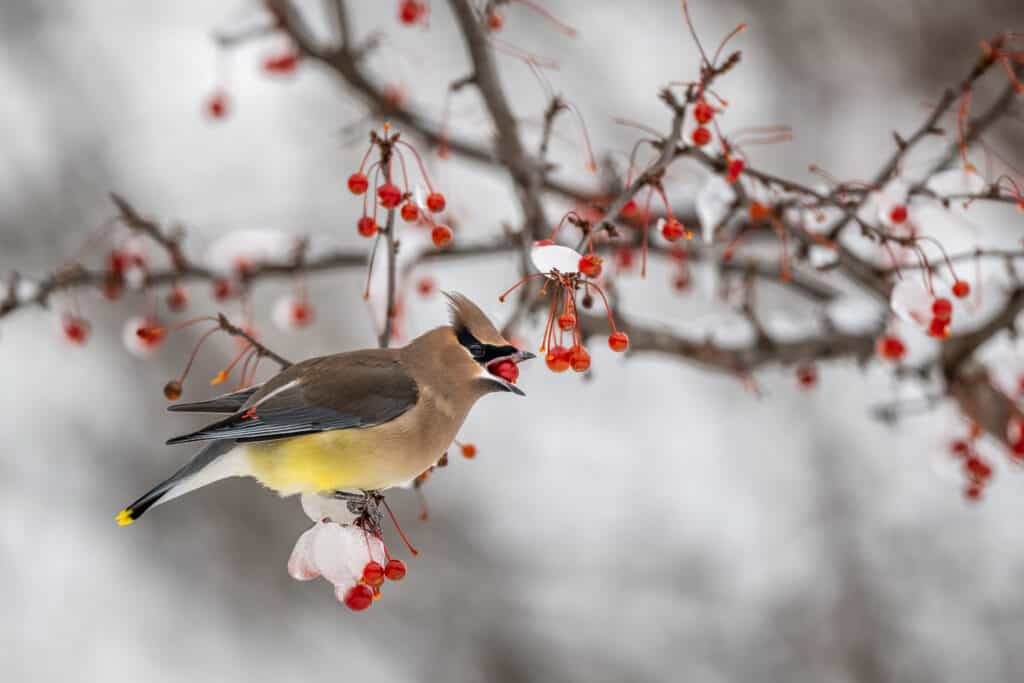
Cedar waxwing diet includes berries, small fruit, flowers, oozing sap, and insects. They feed on various berries like wild cherries and juniper.
©Skyler Ewing/Shutterstock.com
The cedar waxwing has a subtle yellow coloring, especially compared to the yellow warbler. These silky birds live in Minnesota year-round, where you’ll likely find them flocking around berry bushes in fall and catching insects near rivers in summer. They primarily live in woodlands along streams, but you can also find them in fields, grasslands, parks, and gardens. Observe their shiny brown and gray plumage above and pale-yellow wash below. They also have a prominent crest, black eye masks, and waxy red tips on their wings.
Black Birds in Minnesota
Red-winged Blackbird
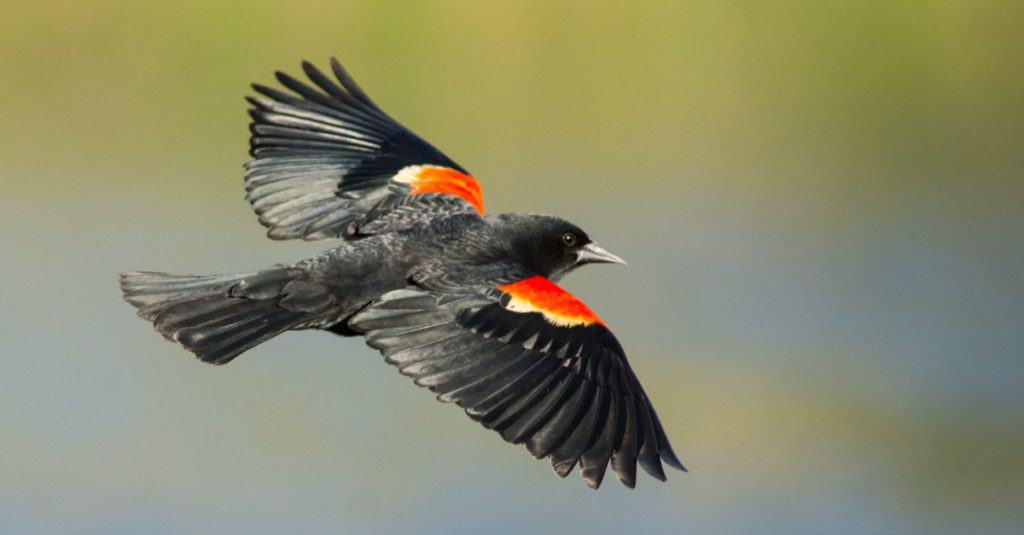
Red-winged blackbirds live permanently in Southern Minnesota and breed in the north.
©JoshCW Photo/Shutterstock.com
If you live in the United States, you’ve most likely seen a red-winged blackbird. They are one of the most abundant bird species in the country. This bird lives permanently in Southern Minnesota and breeds in the northern portions of the state during spring and summer. Look for them in sedge meadows and marshes during the nesting period and in fields, grasslands, and pastures in the fall and winter. You can easily identify this blackbird by its red and yellow shoulder patches.
Common Grackle

The IUCN lists the common grackle as NC or “near threatened.” This species is undergoing a continuous decline in its population.
©JoshCW Photo/Shutterstock.com
Common grackles are abundant in the Central and Eastern United States, where they breed in Minnesota. However, there are year-round populations in the very southern regions of the state. You can spot them in wet, open woodlands and marshes. But they also inhabit more familiar places like parks, fields, and suburban backyards. These large and lanky birds may appear black from a distance, but they feature iridescent purple and blue heads and glossy bronze bodies.
Brown Birds in Minnesota
The Brown Creeper
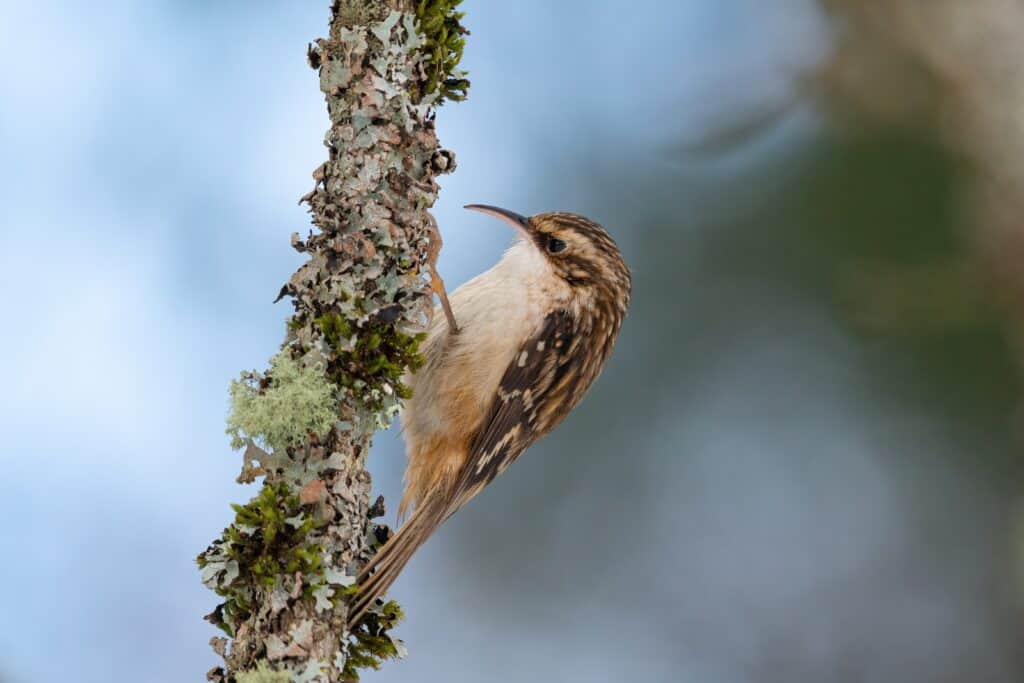
Brown creepers spend winters throughout most of Minnesota, except the northeast corner, where they live permanently.
©2009fotofriends/Shutterstock.com
The brown creeper is an excellent hider as it uses camouflage to conceal its whereabouts in woodlands. While they are rather inconspicuous, they are pretty common across the United States. They spend winters throughout most of Minnesota, except the northeast corner, where they live permanently. They inhabit a wide range of habitats during winter, including mature coniferous forests, parks, suburbs, and orchards. This tiny species is slender with a decurved bill. They feature streaky brown and buff plumage above and white below.
Song Sparrow

The song sparrow lives in a multitude of habitats, including marshes, grasslands, scrublands, pine forests, fields, parks, pastures, and suburbs.
©Trevor Jones/Shutterstock.com
True to their names, song sparrows are prolific, conspicuous singers, especially during springs and summers. This species breeds in most of Minnesota and lives permanently in the southern regions. They live in a multitude of habitats, including marshes, grasslands, scrublands, pine forests, fields, parks, pastures, and suburbs. They are medium-sized songbirds with bulky frames. Their plumage is streaky buff and reddish-brown with gray stripes on their heads. Look for them in dense, low branches, where they perch on exposed branches.
Small Birds in Minnesota
Downy Woodpecker
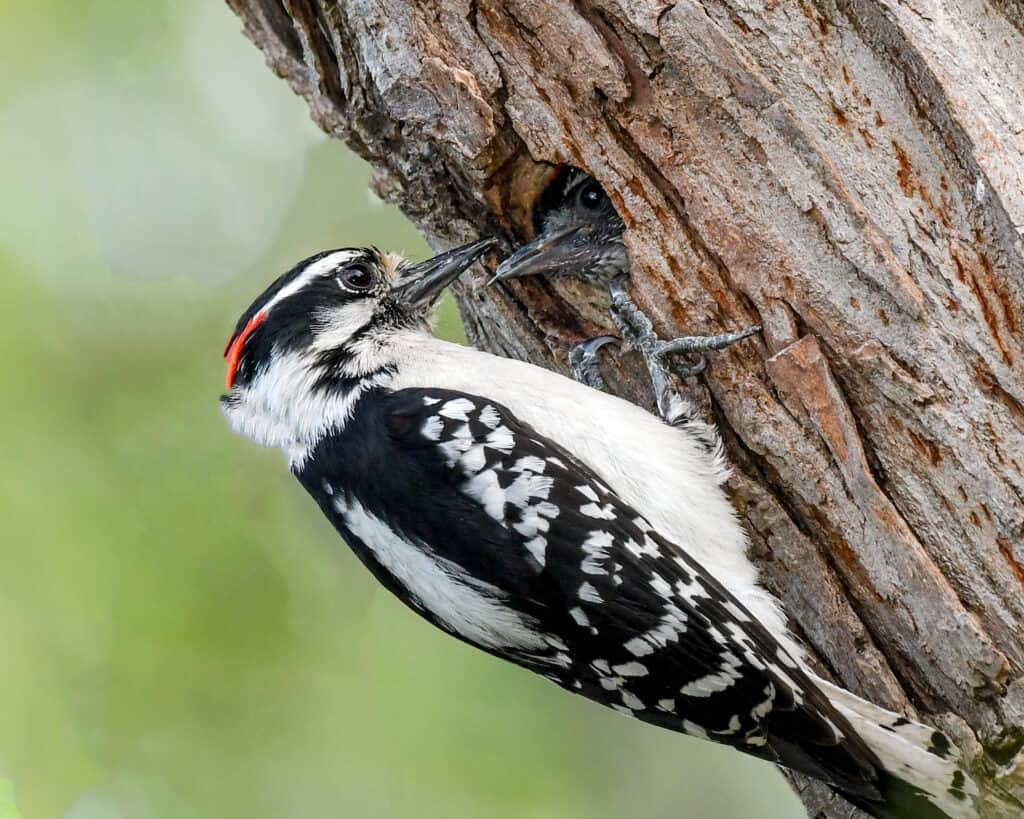
Downy woodpeckers are common in residential areas and city parks, but you can also spot them in deciduous woodlands and orchards.
©Brent Barnes/Shutterstock.com
Active and social, the downy woodpecker is a familiar energetic bird at Minnesota backyard feeders. They live permanently in the state, as well as most of the United States and Canada. They are common in residential areas and city parks, but you can also spot them in deciduous woodlands and orchards. This species is smaller than the hairy woodpecker and feature wide shoulders and a straight posture. They are checkered black and white with a bold white stripe down the center of their backs. Males also have a small red patch of feathers on their heads.
Black-Capped Chickadee
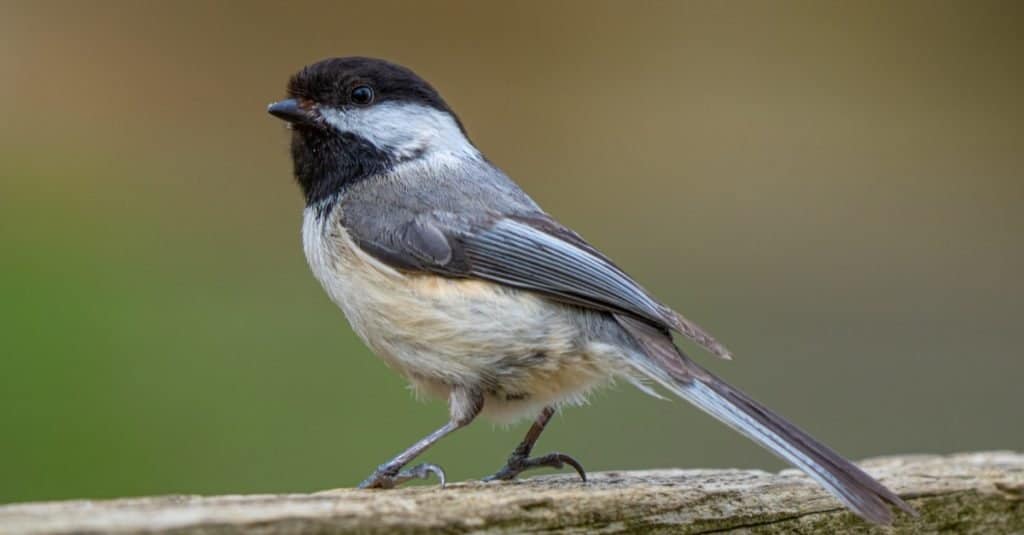
Black-capped chickadees live year-round in Minnesota and throughout the Northern US and Canada.
©J.A. Dunbar/Shutterstock.com
This tiny chickadee is easy to attract to your backyard, especially if you have suet and sunflower seeds. They live year-round in Minnesota and throughout the Northern U.S. and Canada. They live in many habitats, including parks, thickets, groves, deciduous forests, and open woods. Round and compact, the black-capped chickadee features a long tail and a short bill. You can identify them by their black caps and throats and white cheeks. They also have streaky gray plumage above and white below.
Large Birds in Minnesota
Sandhill Crane
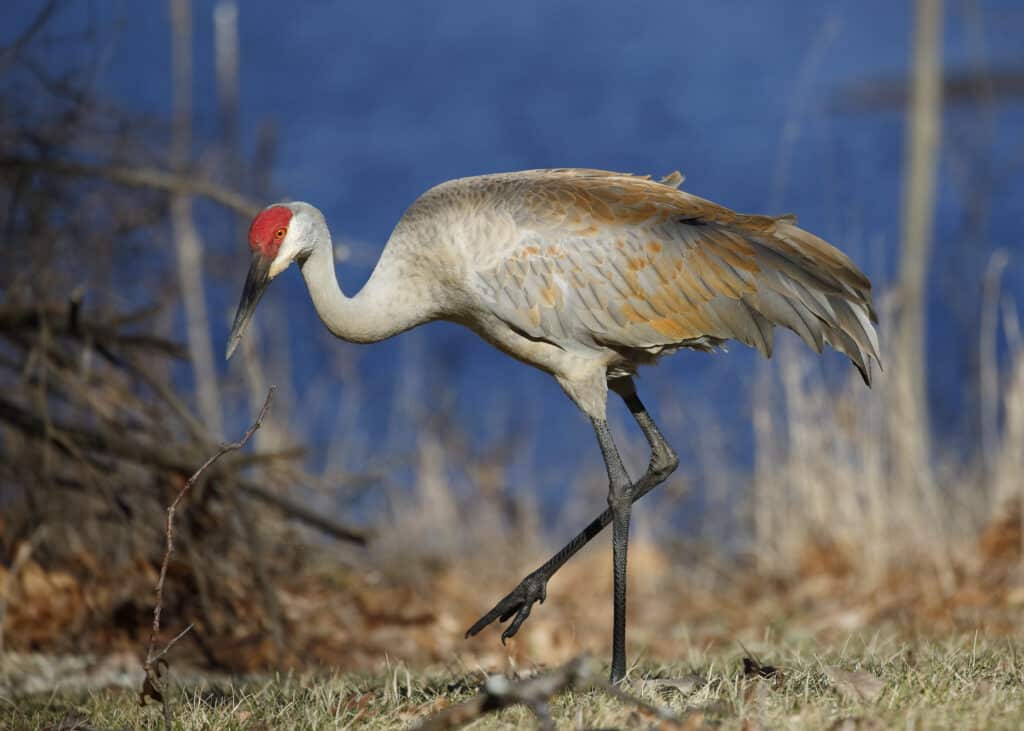
Sandhill cranes are large birds found throughout North America. They are breeding birds in Minnesota.
©Brian Lasenby/Shutterstock.com
Sandhill cranes are large, elegant birds, undeniable in their appearance and flock size. They are breeding birds in Minnesota, with key staging areas in the southern portion of the state. They nest in open wetlands near vegetation. Look for them in marshes, wet meadows, bogs, and other habitats with standing water. Heavier than a great blue heron, the sandhill crane features a long neck and long legs. They are gray overall with a reddish-brown wash. And the bright red skin on the crowns is their most notable feature.
Barred Owl

The
barred owl
is relatively large and bulky and features mottled white and brown plumage.
©FotoRequest/Shutterstock.com
This eastern bird has slowly been making its way west since the twentieth century. Today the barred owl lives permanently through most of Minnesota, except for the far northwest corner. To get a better look at this species, search for them in mature forests near water. They are nocturnal, but you might catch one roosting during the day. This owl is relatively large and bulky and features mottled white and brown plumage. Their wings and tails are heavily barred, allowing them to seamlessly blend with their forested environments.
Winter Birds in Minnesota
Red-Breasted Nuthatch
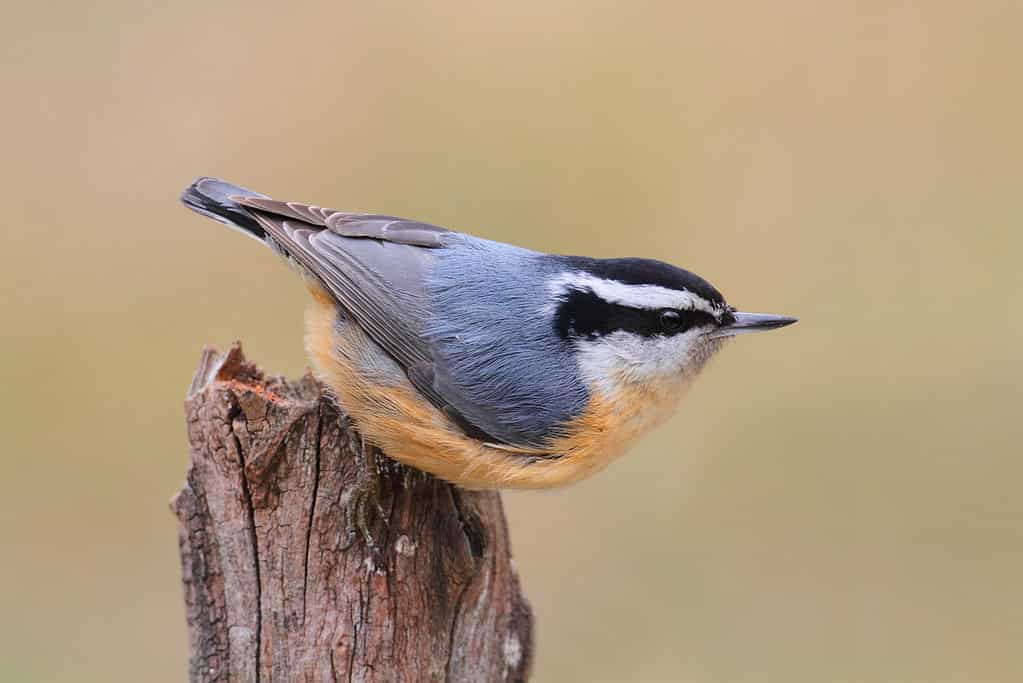
Red-breasted nuthatches are wintering birds in Minnesota, migrating down from Canada. However, there are year-round residents in Minnesota.
©iStock.com/SteveByland
The red-breasted nuthatch is a common species across the United States and Canada. They are wintering birds in Minnesota, migrating down from Canada. However, there are year-round residents in Northeast Minnesota. You will find them in coniferous forests and deciduous woods, but they also inhabit parks and orchards. Look for bluish-gray plumage above and rusty red below, with black and white striped heads.
Northern Shrike

Northern shrikes feed on small mammals and other birds, using their tooth-like spike to quickly immobilize their prey.
©Martin Pelanek/Shutterstock.com
The northern shrike may look like a regular passerine, but these birds are fierce predators in small bodies. They feed on small mammals and other birds, using their tooth-like spike to quickly immobilize their prey. You will find them throughout Minnesota during the winter, where they inhabit semi-open landscapes, such as forest edges and overgrown pastures. These chunky birds have long tails and hooked bills. And they feature gray, black, and white plumage with characteristic black eye masks.
The photo featured at the top of this post is © Rob Palmer Photography/Shutterstock.com
Thank you for reading! Have some feedback for us? Contact the AZ Animals editorial team.







